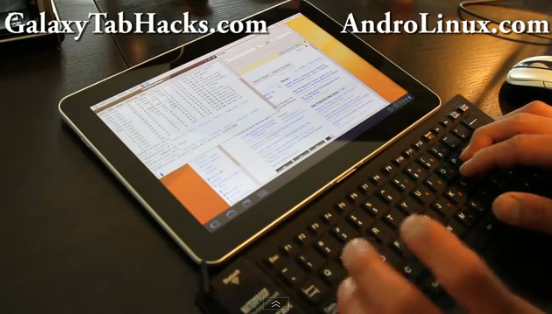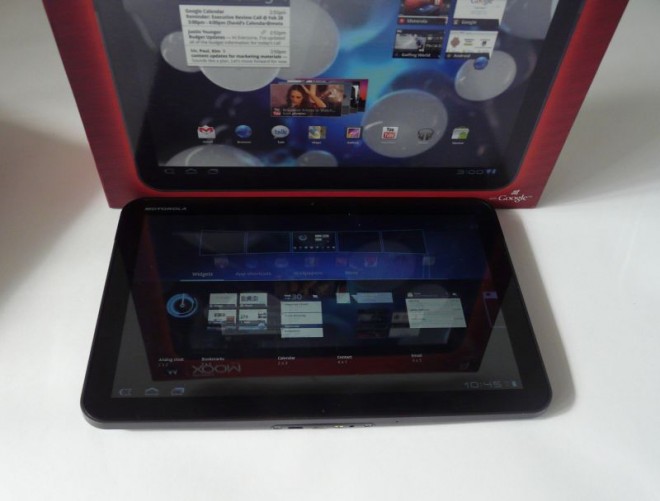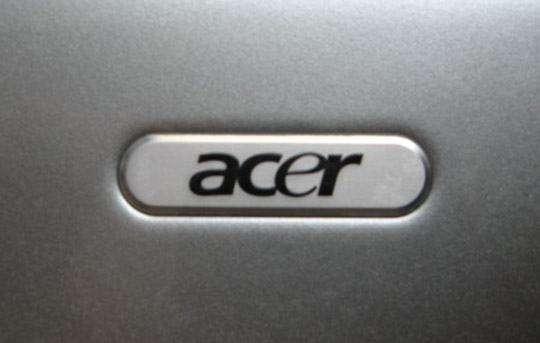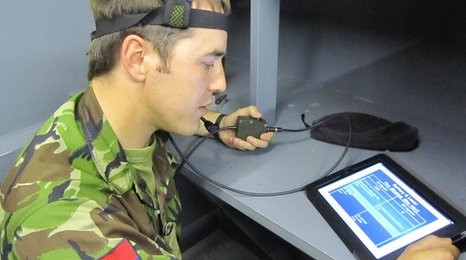A worthy adversary to iPad and Android?


For many, separating the HP TouchPad from it’s webOS Palm origins will be difficult. It picks up many of the nicer features of the Pre phones, including the Touchstone wireless charging option, and of course an operating system that offers the sort of experience that many would want on a tablet. But will HP suffer at the hands of the iPad and the latest and greatest Android tablets?
Design
Setting out in examining the design of the HP TouchPad isn’t the strongest start. It’s relatively fat at 240 x 190 x 13.7mm and a hefty 740g. This makes it fairly substantial, like you are grasping a roof tile rather that the latest piece of tech. But the size doesn’t really worry us that much, as it is comfortable to hold and it looks smart enough.

Until you get to the fingerprints that is. HP have finished the TouchPad in glossy black plastic, so it is a real problem to keep clean. We’ve been polishing and cleaning the thing almost constantly. Of course, you always have to wipe down the screen on a tablet, but having to flip it over and do the same on the back soon gets boring.
But although the TouchPad is a little larger than some, it is rather minimalist in finish. There is a single “central” button beneath the display which also blinks at you when you have a notification and the aperture for the camera at the top (there in no camera on the rear). Around the sides you’ll find two speaker openings, a Micro-USB port, the volume rocker, standby button and 3.5mm headphone jack.

Tablets notionally have no up or down and although the TouchPad will happily auto-rotate (unless you tell it not to) there is definitely a top and bottom here. We get the feeling that the TouchPad likes to be held in portrait, with the central button at the bottom, or rotated to the left. This leaves the speakers at the bottom, the volume rocker at the top (the other way up you’re leaning on the volume control and it doesn’t like that). But this arrangement leaves the headphone jack, we feel, in an awkward place in landscape mode - right where your left hand wants to be holding it and if not holding it, where your arm or wrist will be.
It’s not really a problem for the vast majority of tasks when you can flip it around, however, some applications, or full-sized videos online won’t auto-rotate. Fire up Angry Birds HD and you’ll soon realise how it thinks you should be holding the tablet.
The hardware
It might not mean much in isolation, but the HP TouchPad houses a Qualcomm Snapdragon 1.2GHz dual core processor. We say that it doesn’t mean much because you can’t directly compare across different platforms that linearly. In reality, the webOS user interface is very slick and smooth. There is something of a pause whilst major apps open, but the core apps it offers are integrated and beefy so we actually don’t mind. For example, opening the email client takes longer than firing up Gmail on the Xoom, but once you’re in there, and the app is open, that’s no longer a concern.

Sitting on the front you’ll find a brilliant 9.7-inch IPS display, offering up a resolution of 1024 x 768 pixels. This gives you a 4:3 aspect, so in portrait it is better suited to reading pages than some of its 16:9 competitors. It offers up pixel density of 131ppi, which is a touch lower than most Android, but not by any noticeable degree. However, the display does offer up plenty of brightness and great viewing angles. Daylight will fox it though, with reflections being something of a problem, so like many tablets, it performs best away from the outdoors and windows.
Internally you get the option of 16 or 32GB storage (at ?399 and ?479 respectively). You get all the normal connectivity you’d expect too, including Bluetooth, Wi-Fi, sensors, and so on. The most impressive piece of wireless connectivity is probably the Touchstone technology giving you the option of wireless charging (if you buy the optional dock charger), but you’ll also get touch pairing with your HP Pre3.

This uses a similar radio technology to NFC, although HP’s technology isn’t compatible with NFC standards being pursued by some other mobile manufacturers. Although we haven’t had a Pre3 to test, we have seen the wireless pairing in action and it’s very clever. Essentially, just like the NFC handshake on the Nokia N9 with its speaker, placing the Pre3 on the TouchPad will pair the devices and give you a Bluetooth connection. This will allow you to have the TouchPad perform phone functions, like act as your speakerphone and give you SMS messages, as well as giving you the option to shift things, like webpages, from one device to the other for continued reading, which makes a nice partnership, albeit only one useful to those in the HP/Palm family.
User interface
We got excited about webOS when we first saw it, as the basic operation is simple and intuitive. It offers a highly effective form of multitasking using a card-like interface, similar to what we’ve seen recently from the BlackBerry Playbook. Each application has its own card, so it is easy to visualise what is going on, rather than blindly leaping from one thing to another. It also makes it easy to close an app: swipe the card off the top of the screen and it’s gone. You can glide through the app cards as proper miniaturised windows and punch what you want. So switching between, for example, the browser and your email is simply a case of returning “home” and tapping the email card.

Unlike the iPad or Android you can’t litter the background with applications, these reside in a proper menu at the bottom of the page. This menu is divided into Apps (pre-installed), Downloads, Favorites and Settings. There is a dock at the bottom of the homescreen however offering five shortcuts, so if you have a particular favourite you can always get to what you want from here, a long press letting you switch things around. Some items can also be switched around in the menu, with Favorites letting you group things for easy access.
Sitting at the top of the home page you’ll find a universal search option, Just Type. As the name suggests, typing in here will give you plenty of search options, returning local results, be it people or apps, with options to dive out to Google, Wikipedia, Maps, or even Twitter. You also get a range of “quick actions” taking you off to various forms of messaging. It’s quick, easy and effective.
The central button will take you back to the home page and into that overview-like display, where you can easily leaf through your apps and get on with what you were doing. One especially neat option is when you open a new “tab” in the browser, or reply to an email, this opens up a new card sitting on top of the stack, so using the same principal you can manage different pages in the browser. When it comes to emails, this means you don’t need to save a draft email or discard it, you just come back to that reply card. It also means that if you want to share a photo, you get an email card on the Photos & Video app stack, which helps keep things organised.

Control of user interface is handled in a number of different areas. WebOS makes use of a bar across the top that offers a menu in the left-hand corner (when needed) and drop down notifications on the right, along with pertinent status and settings. Notifications are neat, stacking up icons across the top so you can see what app is talking to you, which you can then go to or dismiss with a neat swipe to the right.
The settings offer you brightness and hardware controls, so you can toggle Bluetooth or wireless, with access to settings for both, along with changing the brightness, so basic settings are a doddle. The approach is pretty much the same in Android 3 Honeycomb and both work nicely without the need to enter the settings menu constantly.
Of course there is a settings menu too, although you don’t really need to access it in daily use. Unlike some devices which offer you menus based on a hierarchical tree, webOS offers them up as individual apps. In that we have some of the beauty of webOS: you arrive at a card and you pretty much always know where you are, whereas other mobile interfaces might return you into an app in some distant side menu. We also like the fact that if you click a link and you didn’t mean to, you can kill the new browser card straightaway by swiping it off the top.
Sweet Synergy
Slick interfaces are nothing if they don’t get you connected and thankfully Synergy swings in to take care of things. One criticism levelled at webOS is that it isn’t bursting with apps like iOS. Instead what it offers you, like HTC Sense on the HTC Flyer does, is a whole range of services right out of the box. The level of cohesion with which these are delivered is impressive, because you won’t find yourself wondering where an app is if it’s integrated into the right place.
If you already have a Palm/HP device with a webOS account, then signing in will get the ball rolling and you’ll find a lot of your connections are made for you, even if some verifications are needed. Yes, you get access to your Google account(s), yes you can setup Microsoft Exchange, but how many other operating systems then go on to offer you Dropbox, Facebook, LinkedIn, Skype, Yahoo! and more? Ok, there is no sign of Twitter which is an obvious omission, but it’s an impressive day 1 selection.

Synergy then fuels a number of different applications, so you’ll find that you have access to your Google calendars in the right place, you have Skype appear in the Messaging app and contacts (with the option to fire up a video call) and so on. It’s very clean and efficient and if you want to add more accounts, you can head into the preferences for each different app and add something in, so long as they are on the list.
Messaging works as a one-stop shop for IM, essentially offering Skype, Google Talk, AIM and Yahoo! Messenger through the same app interface. We’ve been using it a lot, and it works nicely, with lockscreen notifications as well as notifications at the top of the screen when you’re involved in something else.
Core applications: Email, Calendar, Contacts, Maps
We spend a lot of time talking about the “core applications” when we review phones and tablets. In essence we are talking about the things that we consider to be the most important. They are the apps that, if you had nothing else, make a mobile device worth having. Given the space on offer, the core apps are efficient and gloriously simple. Controls are easy to find and the layout is clear. A number of webOS apps make use of sliding layers, where you easily drag a section of the app across to make it bigger and shift the emphasis of what you are looking at. In the case of email this means you can move from three columns to two and really get into the detail.

Calendars are bright and clear and you get the run of customisation options, from picking which calendars are shown, to what colour you want them to be. Switching from day to week to month view is a button press, although we miss Google’s agenda view. Cleverly you can click on a location or the directions button to get a route displayed for you or just a straight map of the destination.
Contacts presents plenty of information on your people. You can pick and choose which contact lists from which accounts are included, and Synergy does a good job of combining details so you don’t get too much duplication - although we did have to do some tidying up. We did find that Contacts was a little slow to scroll through our full list, stuttering and stumbling as though it was really having to think about what it was doing, a far cry from inertial scrolling you’ll find elsewhere. But we like the fact that you get contact options, linked maps and so on. Seeing as accounts are linked, we’d have liked to be able to dive from a contact straight to their Facebook page or LinkedIn profile, but that’s not an option.

Maps may be less essential on a tablet than on a mobile phone, but when it comes to organising yourself, be it as a tourist or with a busy schedule of meetings, then mapping has to work. Maps now come from Bing, rather than Google. They still contain more or less the same information and we found them to be fast enough to serve up a location, but don’t get access to Google’s Street View. What you do get though is Bird’s Eye view, which will serve you up some very cool maps none the less with some great 3D-ish views.
This being a tablet coming from HP, it’s perhaps no surprise to find there are print options all over. We didn’t actually manage to get anything to print due to the lack of an HP printer, but if you’re equipped with one then you’ll be in for a rare treat and anyone who has ever needed to print from an email will welcome the support.
Browser and keyboard
For any mobile device, the browser plays an important role. It’s the point you come back to when you don’t have a specific app for a service. No BBC iPlayer app? It doesn’t matter. Flash support means it will play in the browser, as will other catch-up TV services. We did encounter some problems - playback would occasionally crash into endless buffering, or we’d lose the sound, but we’re impressed with how straightforward and complete the web experience feels.
Cards can effectively be used like tabs, with a long press on a link offering up the option of opening in a new card, sharing and so on. Sharing isn’t the integrated offering you’ll find in Android, as “Share link” opens up a new email and that’s your only option, so it’s not quite as friendly as we’d like.
One of the surprising pleasures of the TouchPad is the keyboard. It is sensibly arranged and the size of the device means we can just about type with two thumbs when gripping at the side. Character keys are arranged on four lines, the top line being numbers, with sensible alternative characters, reflecting the common arrangement on a computer keyboard, accessed via a long press. Alt characters on the regular keys are probably going to get less use, but give you access to different language variants and the odd symbol.
It’s all logical and works nicely. The response is great and we like the touch pulse point you get when you touch the face of the TouchPad. Copy and paste also works well and is certainly less fiddly than the current arrangement on Honeycomb.
Work or play? Media and documents
Dive into the Photos & Video app and you’ll find not only local files, but those from online services too, like Facebook. With no break out of video files, it might be worth nominating a video folder so you don’t have to wade through all the files looking for your videos, so navigation of a large collection isn’t the easiest. Video file support out of the box is MPEG4 H.263 H.264, with no sign of support for any other common formats. There is also no support for network media out of the box, so you can’t just stream content off your network drive.

Video playback does look good on the TouchPad display, with a simple button to change the aspect to either fit the screen or stick to the original. We found it handled MPEG4 of various types up to 1080p, which played smoothly. Other formats it refused to acknowledge and strangely, it wouldn’t give us a thumbnail for any of our videos, so we just had a selection of grey movie icons and no idea what was what.
The music player is rather straightforward, but hits the key points of offering shortcut controls up with your notifications as well as from the lockscreen, which is less common on tablets. The TouchPad also brings with it Beats audio. There is only so much you can do from the small onboard speakers and we found that as the volume was cranked up the plastic back of the casing started to vibrate a little uncomfortably. Headphones, however, sound great.

Quickoffice is pre-installed, along with a PDF viewer so you won’t have a problem viewing documents. Opening up attachments to emails and saving them locally is no problem, but the most exciting thing about document handling again comes from Synergy.
Because it knows about your Google or Dropbox accounts, the TouchPad will offer you access to your Google Docs in Quickoffice. With very little fuss you’ve got access to your online files, although there is one problem: you can’t edit them. We understand that editing functions are coming in the future.?
App Catalog and Pivot
The HP App Catalog isn’t empty, but it also isn’t as fully featured as Apple and Android. It’s not that apps aren’t necessarily there, but it might be that you don’t find what you’re looking for, or what you’ve been shown by another tablet user. Of course the current leader for tablet specific apps is the iPad, but that doesn’t mean that there aren’t TouchPad specific apps too. They don’t get their own section in App Catalog, which would be really nice, but they are indicated as “For TouchPad”.

In truth you don’t really need a separate section for them, because the App Catalog app will return TouchPad apps at the top of the list. There are plenty on offer designed for the TouchPad, although regular phone apps work too. There are some reasonably familiar names in there including Facebook, WeatherBug, WordPress, Groupon, TuneIn Radio and Angry Birds HD.?The TouchPad is one of the first to get a dedicated Facebook app and it’s a delight, much better than hacking your way around an enlarged phone app like you have to do with Android.
In reality, app satisfaction will be dictated by expectation. Existing Pre owners will know what to expect, and will potentially be perfectly happy with what is on offer, but iPad owners may snort with derision.
One thing that doesn’t help is navigation of the App Catalog in general. At times it just feels a little too slow and we found search to be infuriating. Pause for a second when entering a search string and it will be off looking for the letters you’ve entered so far. Fine in the world of instant results, but you’re then stuck while it searches, unable to back out, correct or continue what you were doing.

Pivot, recently announced, is an integral part of the App Catalog and is certainly innovative. Rather than just thrusting a selection of “Featured” apps in your face (which App Catalog also does…), Pivot is effectively a digital magazine all about apps. It’s a place that “organizes, curates and presents apps”. It’s beautifully put together and we’ve found ourselves reading around all sorts things we’d perhaps otherwise ignore. It is a little like the in-flight magazine, where you find yourself reading about Moroccan cuisine, rather than reading your briefing document.
The success of Pivot will hinge around engagement, variety and balance. As long as the quality is good, as we’ve found the Discovery Issue to be, we’re sure that people will read it. In fact, we can’t believe that no one else is doing it. If nothing else it takes the sting out of the app position of the TouchPad, as it gives you a sense of the greater app environment and we’re guessing that was exactly the point.
We’ve seen more apps featured than we’ve been able to access so far, so we guess that following launch we’ll see a number of them hit. Of interest are the Kindle app and the HP MovieStore powered by RoxioNow.
Final points?
The interface is refreshing and easy to use, whilst perhaps being more refined than the rawness of Honeycomb and more sophisticated than the back and forth nature of iOS. But it hasn’t been completely stable for us and we’ve managed to crash the tablet a number of times, and we’ve had some unexplained restarts. These points, and the occasional struggle to scroll completely smoothly, or failure to supply a thumbnail, suggest that the software isn’t quite there yet.
But putting that into context, we’ve found similar problems with Android 3.1 and that’s now been out for several months. When the TouchPad lands, hopefully everything will be in order, or soon thereafter.
The battery life looks strong too, letting us go a couple of days between serious charging and the simplicity of perching it on the Touchstone charger can’t be questioned. When perched it will launch Exhibition, an app that will let you display clocks, your agenda or a photo slideshow.
Verdict:
The HP TouchPad will be the perfect tablet for a lot of people. The points we love about webOS pour into HP’s tablet bringing with it an experience that rivals the iPad and the best from Honeycomb. The intuitive nature and the wide support of Synergy means that you don’t feel you are missing out on core features with the HP TouchPad.?
But it’s not all perfect. We have some stability quibbles and at times webOS wasn’t as slick as you’d expect. In the highly-polished world of the iPad, the TouchPad seems to have a few software obstacles to overcome just as Honeycomb does. Then there is the question over how quickly we’ll see great tablet-specific apps arriving. Android’s growth as a mobile phone platform stands it at an advantage over webOS when it comes to apps, and the wide-ranging physical connections on Android tablets (HDMI, USB, microSD) aren't on offer here.
That leaves us in the position of pinning the TouchPad down. Like the original Pre, it’s a great user experience in a device that lacks the premium build of some rivals. There is room to expand the offering of the TouchPad as well as improve some areas of current performance.
If core functionality - email, browsing, contacts - are what interest you, then the HP TouchPad will serve you well and it deserves a high score. If it’s an all encompassing world of multimedia delights, services or physical connections, then you might want to look elsewhere.
?
Tags:
Tablets HP HP TouchPad webOS

































HP TouchPad originally appeared on http://www.pocket-lint.com on Thu, 30 Jun 2011 03:30:00 +0100




























































































